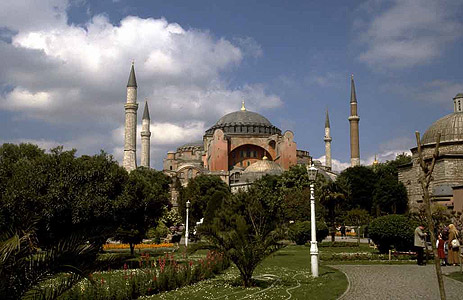Image Resource Bank
Image Gallery |  13 of 15
13 of 15 
A Christian Church Converted Into a Mosque
The grand church of Hagia Sophia (Greek, “Holy Wisdom”) was constructed during the sixth century CE on orders from the Byzantine Emperor Justinian and served as both the seat of the Patriarch of Constantinople, head of the Eastern Orthodox Church, and as a center for coronations and other major ceremonies of the Byzantine imperial court. For a long time, it was the largest church in the world. The great dome fell because of earthquakes several times between the sixth and tenth centuries, but was always promptly rebuilt. In plan, Hagia Sophia is a typical domed basilica, the domes and arches creating a covered open space of awe-inspiring height and extent. After Constantinople fell to the Ottomans in 1453, ending the Byzantine empire, the Ottoman rulers converted the church to a mosque that became the model for many subsequent Ottoman mosques. Four large minarets were added to the complex, and Christian representational art was removed (icons) or plastered over (mosaics) in order to bring the interior in harmony with the canons of Islamic religious art (see image 11). In 1935, during the secularizing drive of the new Turkish republic and its founder, Atatürk, Hagia Sophia (Ayasofya in Turkish) was converted into a museum.
Name: Hagia Sophia (exterior)
Material: Stucco, marble, mosaic
Size:
Height: 55 m (180 ft)
Length: 82 m (270 ft)
Width: 73 m (240 ft)
Date: 6th century CE
Place of Origin: Istanbul, Turkey
Location: Istanbul, Turkey
Registration # and Source: World Images. Link to resource![]() (accessed April 27, 2010).
(accessed April 27, 2010).
Attribution: Work by Allan Kohl
Location: WorldImage Kiosk, California State University
Material: Digital photograph
Size: Unknown
Date: Unknown

 Fred M. Donner
Fred M. Donner
Professor of Near Eastern History, University of Chicago




